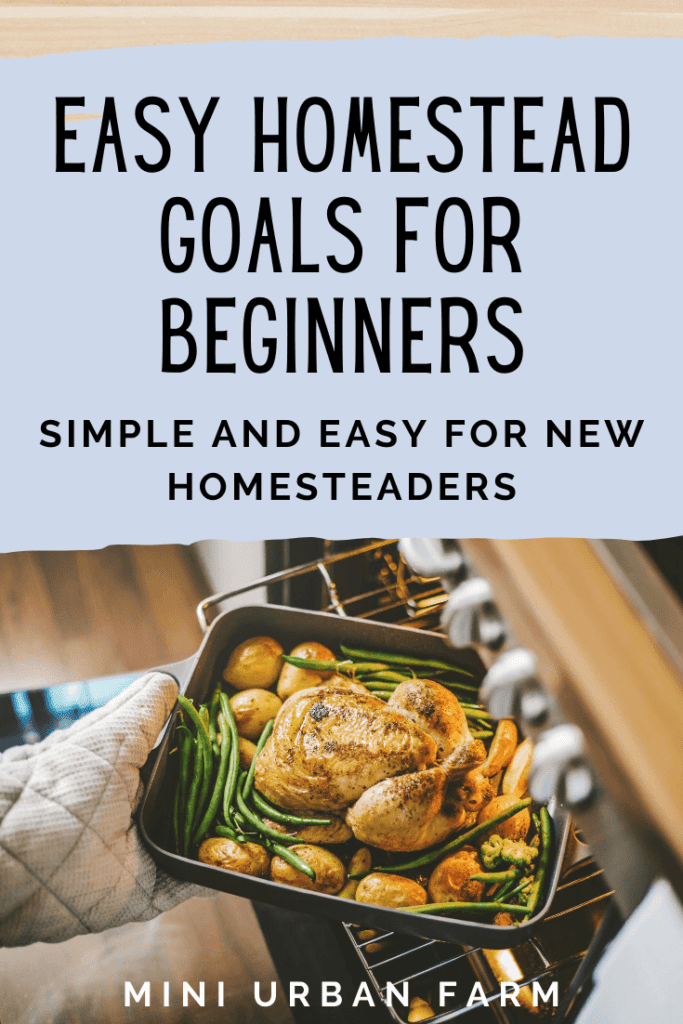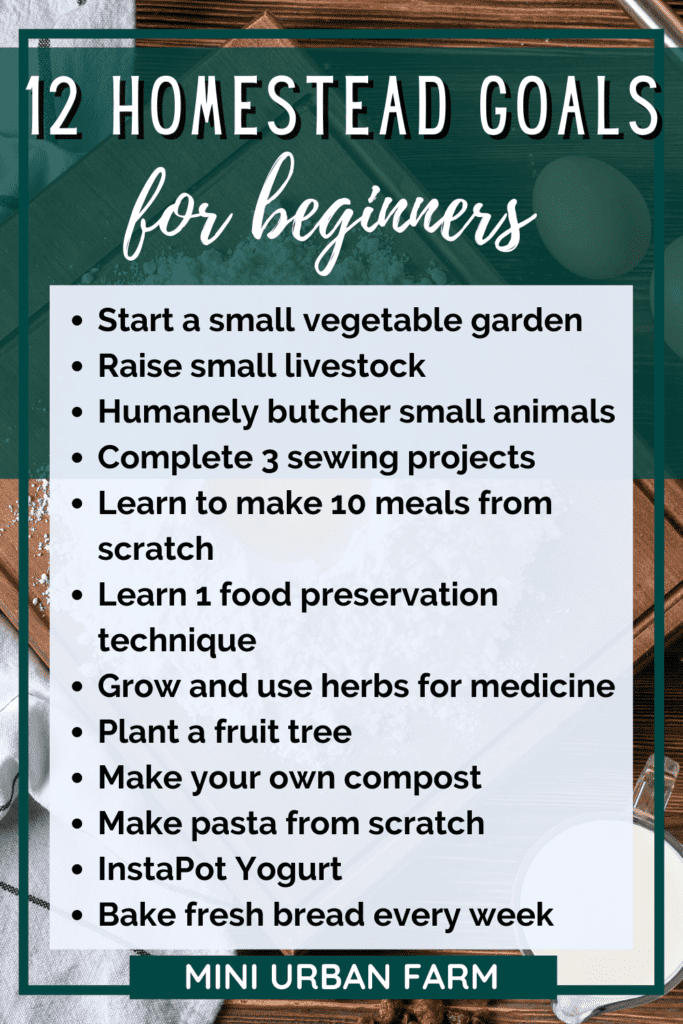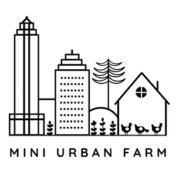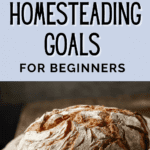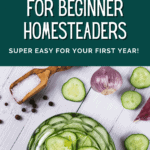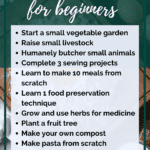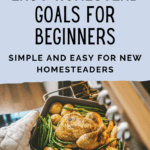When I first started homesteading I had no clue where to begin. What is considered homesteading? How do I get started? What order should I do things in? Well, after several years of implementing some homesteading techniques in the suburbs, I’ve come up with this very straightforward list of homesteading goals for beginners!
12 Easy Homesteading Goals for Beginners:
- Start a small vegetable garden
- Raise small livestock
- Humanely butcher small animals
- Complete 3 sewing projects
- Learn to make 10 meals from scratch
- Learn 1 food preservation technique
- Grow and use herbs for medicine
- Plant a fruit tree
- Make your own compost
- Make pasta from scratch
- InstaPot Yogurt
- Bake fresh bread every week
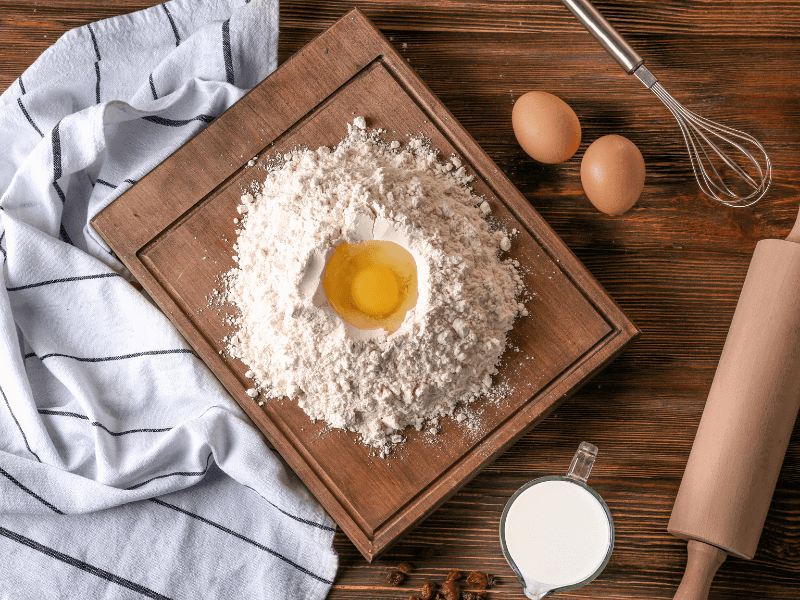
Disclosure: This post may contain affiliate links. If you purchase a product through one of our affiliate links we make a small commission from the sale at no extra cost to our readers.
HOMESTEADING GOALS FOR BEGINNERS
I don’t know about you, but for me it’s super helpful to have a checklist of goals that I can work towards. Especially when I’m first learning something new!
Check out the beginner homesteading goals below and decide which ones you want to start with!
1. START A SMALL VEGETABLE GARDEN
A large part of homesteading is growing your own food. So naturally, starting a vegetable garden is step one.
Of course, you don’t need to start with a 3000 square foot garden.
Start with something small and expand as you grow – literally!
One of my very first gardens was only a few tomato plants and some bush beans. Starting small let me focus on growing those things well, before moving on to more advanced crops.
Plus, there are so many types of gardens you can start with!
You can make an herb garden – or a tea garden. Or even a cocktail garden!
The possibilities are endless – even if you live in the suburbs.
Heck, for the past year and a half I’ve been growing all of our own herbs and veggies in about 450 square feet. On the side of our house in an HOA regulated community!
For more tips and tricks on suburban gardening check out these posts!
2. RAISE SMALL LIVESTOCK
Making the jump from gardening to livestock is the next step to urban homesteading – or any type of homesteading for that matter!
Of course, if you do live in Suburbia like we do, you’ll want to start off small. But starting off with small livestock can be a good idea no matter where you live.
For example, instead of starting off with chickens (which take up extra space and can be noisy and smelly) consider starting with quail. Not only are quail small and take up less space, but they’re quieter and their eggs are actually more nutrient-dense than chicken eggs!
Other great options are rabbits, bees, and worms (yes, worm farming is actually a thing!)
But even if you do opt to start with chickens, learning to raise livestock is one of the main homesteading goals for beginners!
3. HUMANELY BUTCHER SMALL ANIMALS
Of course, if you do keep animals on your homestead for meat, you’ll need to learn to process them at some point.
I put this off for a long time, but in the end it wasn’t nearly as traumatic as I thought it would be.
The main thing I like to remember is that butchering an animal humanely for consumption is much better than that same animal getting slaughtered in a factory. That alone makes it worth it for me.
Plus, if you are raising animals for meat, learning to dispatch them yourself will save you lots of money down the road.
I started this journey with quail. Then chicken. And next up – rabbits. But I’m still working my way up to that one!
4. COMPLETE 3 SEWING PROJECTS
In the olden days, sewing used to be an essential part of many households. Nowadays, we either throw away clothes when they break or send them off to be fixed (for a hefty price!)
But learning to sew and mend clothes is a huge step towards self-sufficiency. And chances are you won’t need any advanced sewing skills – just your run of the mill basics of sewing!
So pick 3 basic sewing projects that you can practice with. Once you have those down, you can graduate to more advanced sewing projects – like sewing those rabbit hides into pillows after you’ve processed them!
5. LEARN TO MAKE 10 MEALS FROM SCRATCH
Cooking from scratch can definitely be time consuming. But learning how to make a few simple meals will dramatically propel you towards your homesteading goal.
I cook from scratch almost every day. And after a while it just becomes part of daily life.
Which means that instead of spending $60 on dinner for a family of four, we spend about $10 (or even less sometimes!)
Plus, homemade food is so much healthier for you. You know, because when cooking at home we don’t typically add in all those chemicals that fast foods tend to have!
My recommendation if you’re just learning to cook is to pick a few dishes you normally eat, and learn to make those well.
Aim for a variety of foods, however. A few chicken dishes, a few pork, etc. Throw in some side dishes, an appetizer or two, and a few desserts and you’re well on your way to homestead goal #5!
6. LEARN 1 FOOD PRESERVATION TECHNIQUE
Preserving food is one of those forgotten homesteading skills that many people don’t know how to do anymore.
But if you’re growing your own produce, you’ll often have extra and you won’t want it to go to waste.
And you can even preserve foods you buy from the store or farmers market, you know just in case the grocery stores are out of food one day…
There are so many ways to preserve food. You can cook and freeze meals, blanch and freeze veggies, dehydrate vegetables, fruits, and meats, learn to can almost anything, or even preserve in salt or by water-glassing!
Pick just one to get started with and expand your skillset as you go!
7. GROW AND USE HERBS FOR MEDICINE
Many common ailments can be treated with herbal medicines. So why not learn about some of the benefits or medicinal herbs and plants? And then plant some!
As a homesteader, learning to make herbal medicine is one of the most amazing self-sufficient skills you can have. Because not only can you grow those plants in your garden to cook with, but you can also prevent a doctor’s visit later on down the road!
This one definitely comes with some research, though. And one of the best books I’ve read on this topic is the Encyclopedia of Herbal Medicine!
8. PLANT A FRUIT TREE
One of the best ways to ensure a food crop is by planting trees.
Not only will the continue to produce year after year, but they provide shade for understory crops and need little maintenance also!
So while I love my annual garden, planting a fruit tree is a much more efficient way to grow food!
The type of fruit you can grow will depend on your gardening zone. And if you aren’t sure what that means you can look up your zone on the Farmer’s Almanac website.
For example, I homestead in zone 9. Which means that I can grow most tropical fruits, as well as some cold weather fruits – as long as they have relatively low chill hours.
A great way to find out what trees will do well in your area is by simply looking up “your zone” + fruit trees on Google. This will bring up a whole list and the requirements for each tree!
9. MAKE YOUR OWN COMPOST
On the Mini Urban Farm YouTube channel I talk a lot about making my own compost.
Because what better way to reuse kitchen scraps than by using them to grow even more food?!
And composting is not nearly as difficult as many people think – even in your backyard!
You start with a compost bin – I like this one since it has 2 compartments for faster composting.
Then add some compost friendly kitchen scraps.
Turn the pile from time to time – I really only do this when I remember.
And give it some time to work its magic!
A few months later you’ll have homemade compost to add to your garden soil, or even make your own seed starting mix with. One of my absolute favorite ways to garden on a budget!
10. MAKE PASTA FROM SCRATCH
If you really want to impress your friends, invite them over for dinner and serve some homemade pasta. And I don’t mean just pasta that you boiled and added homemade sauce to – I mean homemade pasta dough!
It’s actually surprisingly simple to make homemade pasta, and extraordinarily cheap too!
That’s why pasta making is a great homesteading goal for beginners. And bonus points if you use eggs from your own backyard chickens like I do!
And there are so many different types of pasta you can make. I use this cheap pasta maker to roll out my dough, and cut it into fettuccine, spaghetti, or lasagna noodles.
And if you really want to get creative – this is my all time favorite book of pasta recipes!
11. INSTAPOT YOGURT
Did you know you can make yogurt at home? Well, you can!
And it’s super simple to make!
Every week I whip up a fresh batch of plain yogurt, which I serve with breakfast or use in recipes throughout the week. Plus, keeping it plain allows me to add in other flavors and toppings as I go.
Not only is it cheap, but it requires almost no effort! And I can be sure that it doesn’t have extra coloring or artificial sugars like store-bought yogurt.
Bonus points if you use milk from your own animals!
12. BAKE FRESH BREAD EVERY WEEK
I think we can all agree that there’s nothing like fresh homemade bread. Even just the smell of fresh bread baking is enough to make me smile.
But making fresh bread is definitely time consuming!
Between kneading the dough, letting it rise, and actually baking it – it takes more time to bake than to actually eat!
That doesn’t stop me from making homemade bread though. And I’ll let you in on my secret. I have a bread machine. Specifically this amazing bread machine!
All I do is add in the ingredients (all at once – none of this separating the wet ingredients from the dry ones), pick my settings on the machine, and take it out when it’s done.
The machine does everything else. So if you haven’t gotten yourself one yet, it’s definitely a life-changer!
Or, you can opt for the more traditional route of making bread by hand. Either way, learning to make bread is one of the easiest homesteading goals for beginners to check off the list!
HOMESTEADING SKILLS FOR BEGINNERS
Many of these beginner homesteading goals are based on the basic homesteading skills you’ll need to set up and maintain a homestead. Below are some of the most important ones:
- Cooking from scratch – in order to save money and maintain your health, cooking at home instead of buying all your meals is an essential skill to have
- Preserving food for later – in the event of a food shortage, you’ll be thankful to have a well stocked pantry filled with all your favorites
- Building basic structures – learning to use tools and build a garden, a greenhouse, a shed, or animal shelters will save tons of money. Both on the initial construction and on the repairs
- Seed saving – one of the best ways to save money on gardening, and ridiculously easy to do
- Mending clothes – sewing on a button or hemming a dress shouldn’t have to be outsourced to a tailor. By simply learning a few basic sewing techniques you’ll save yourself tons of money
- Hatching eggs – no need to buy chicks from the hatchery when you can hatch your own, right in your kitchen
- Butchering animals – this one will take a mental shift if you’re not used to it, but one of the best ways to become self-sufficient
- Taking care of sick animals – if you have lots of animals, being able to care for them without calling the vet will save you tons of money
Use this list of homesteading goals for beginners and the homesteading skills above to start your journey towards your own homestead! And don’t forget to keep expanding and learning more advanced skills as you go!
PIN HOMESTEADING GOALS FOR BEGINNERS!
